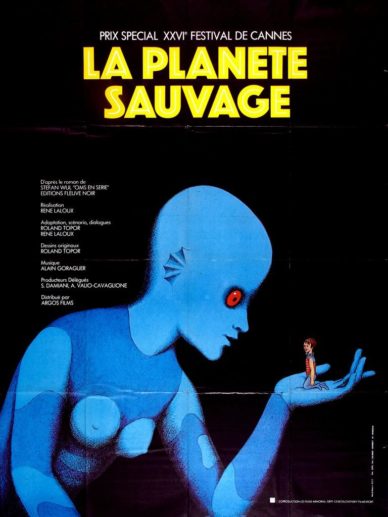 If ever there was a film that shouldn’t work it’s this animated French-Czechoslovakian co-production from 1973, marked by unbelievably primitive animation, stilted dialogue and outrageously dated music. Yet somehow FANTASTIC PLANET (LA PLANETE SAUVAGE) succeeds, and extremely well, being (after THE YELLOW SUBMARINE) the premiere example of feature-length psychedelic animation.
If ever there was a film that shouldn’t work it’s this animated French-Czechoslovakian co-production from 1973, marked by unbelievably primitive animation, stilted dialogue and outrageously dated music. Yet somehow FANTASTIC PLANET (LA PLANETE SAUVAGE) succeeds, and extremely well, being (after THE YELLOW SUBMARINE) the premiere example of feature-length psychedelic animation.
…FANTASTIC PLANET (LA PLANETE SAUVAGE) succeeds, and extremely well…
Loosely adapted from a 1957 French language novel by Stefan Wul (translated into English in 2010), FANTASTIC PLANET was the premiere feature by René Laloux (1929–2004). It was made in collaboration with the playwright/artist Roland Topor (1938-1997), who co-wrote the script and provided the designs from which the animation was created. Further Laloux features include THE MASTERS OF TIME/LES MAITRES DU TEMPS (1982) and GANDAHAR (1987), neither of which approached the mind-bending charge of FANTASTIC PLANET (although GANDAHAR did come close). Topor for his part went on to script the comedic TV series PALACE (1988-89) and the notorious puppet feature MARQUIS (1989).
The production of FANTASTIC PLANET took five years (due in part to the 1968 Russian invasion of Czechoslovakia), but the finished film won a special award at the Cannes Film Festival and was a massive hit in France. Its English language release, with dialogue spoken by a cast that included Barry Bostwick and Cynthia Adler, was also well received; the first-ever animated feature to be rated GP (or as it’s known these days, PG) in the US, FANTASTIC PLANET played the midnight movie circuit quite successfully. Indeed, it’s said to have permanently changed how we yanks view animation, something that to Americans in the early 1970s was restricted to Disney features and Saturday morning cartoons.
The production of FANTASTIC PLANET took five years (due in part to the 1968 Russian invasion of Czechoslovakia), but the finished film won a special award at the Cannes Film Festival and was a massive hit in France.
As a political allegory the story’s bonafides are pretty obvious, with oppression, revolution and pacifism all given lip service, but the film functions best as a psychedelic spectacle. The Roland Topor created imagery, which includes heads detaching from bodies in a meditation ritual that sees those heads fastening onto the necks of statues that then perform bizarre fertility dances, diamonds springing up from the ground and torsos literally twisting themselves into knots and coalescing into the bodies of others, has am curiously elemental quality that nearly forgives the dialogue, which is uniformly flat and expository (with the Oms and Draags conveniently speaking the same language). In truth the film would probably have worked better without dialogue.
In truth the film would probably have worked better without dialogue.
That leaves us with the acid jazz-tinged score, filled with sixties-centric guitar twangs and whirs, by Alain Goraguer. Dated though Goraguer’s work is, it imparts an authentically otherworldly ambiance. So too the halting two-dimensional animation, which proceeds in fits and starts, with character movements only utilized when absolutely necessary—yet like the music the visuals have an elemental strangeness that perfectly complements the setting and subject matter.
Vital Statistics
FANTASTIC PLANET (LA PLANETE SAUVAGE)
L’Institut National de l’Audiovisuel/Ceskoslovensky Filmexport
Director: René Laloux
Producer: Anatole Dauman
Screenplay: Roland Topor, René Laloux
(Based on a novel by Stefan Wul)
Cinematography: Boris Baromykin, Lubomir Rejthar
Editing: Hélène Arnal, Marta Látalová
Cast: Jennifer Drake, Eric Baugin, Jean Topart, Jean Valmont, Sylvie Lenoir, Michèle Chahan, Yves Barsacq, Hubert de Lapparent, Gérard Hernandez, Claude Joseph, Philippe Ogouz, Jacques Ruisseau
